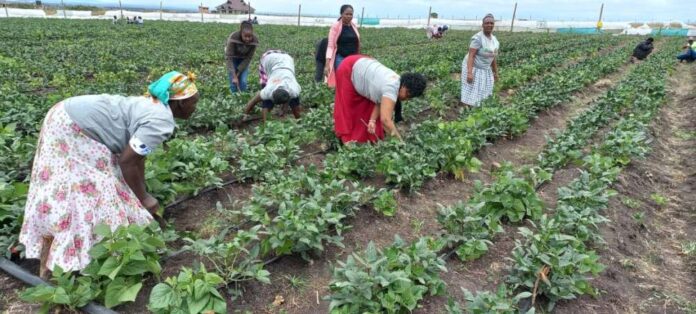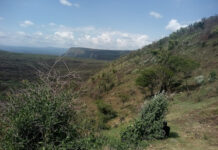By Christine Musa, DevReporter, Kajiado County

Key Highlights
- Several factors have contributed to this shift, including prolonged drought, shrinking land parcels, and the need for nutritional variety.
- Hundreds of cattle have perished due to starvation, as the lack of pasture and water becomes more persistent.
- The county government of Kajiado, along with development partners and non-governmental organisations, has significantly invested in training women in crop farming.
Recently, women from remote villages in Kajiado have started practising crop farming, moving away from milk sales, their traditional economic activity.
Several factors have contributed to this shift, including prolonged drought, shrinking land parcels, and the need for nutritional variety.
Climate Change
In recent years, the effects of climate change have become evident, marked by prolonged droughts. Consequently, hundreds of cattle have perished due to starvation, as the lack of pasture and water becomes more persistent.
For instance, in Kajiado County, at least one million cattle succumbed to hunger during the 2022-2023 drought, according to the National Drought Management Authority (NDMA).
The prolonged dry spell reached an alarming phase, as reported by the authority.
This drought has significantly decreased the number of cattle, thereby affecting milk production.
Extensive Land Subdivision
Kajiado has also experienced a reduction in land size due to high land demand and rapid population growth, leading to extensive land subdivision for real estate development.
This subdivision has resulted in a decline in the number of livestock a farmer can maintain, as traditionally, farmers in the area relied on free-range grazing.
With fewer cattle, men—who have traditionally been the sole breadwinners—have lost their primary source of income.
Consequently, women are now compelled to seek alternative means of feeding their families.
Additionally, women aspire to continue funding their chamas (community savings groups), necessitating their involvement in economic activities due to reduced financial support from men.
Balanced Diet
As traditional staple foods like meat and milk have become scarce, there is an increasing need for a balanced diet to combat malnutrition, driving the desire to cultivate a variety of crops.
Esther Shonko, a member of a women’s farming group called Kokosho, states that they grow various vegetables, including some new variety, to their community.
“For many years, I only knew sukuma wiki, spinach, and cabbage. This new practice has introduced a range of vegetables to my family’s table. I now know of managu, sagaa, among others. As a mother, I feel that I am now providing a balanced diet for my family,” she explains.
However, the women face challenges in this new economic venture.
Lack of Knowledge
Given that the Maasai community has traditionally focused on livestock keeping, a lack of knowledge about effective crop farming practices remains a significant hurdle.
Understanding soil fertility, selecting the best varieties of crops, and knowing how to use pesticides safely, limits the range of crops that these women can cultivate.
“We have no first-hand experience regarding land tilling and crop cultivation. I am sure there are other women here in Kajiado who are interested in what we are doing but lack the knowledge on how to pursue it,” says Mrs. Shonko.
Despite this, the women remain optimistic, noting the startup support they are receiving.
They encourage fellow women to form groups to take advantage of available opportunities.
“The training and facilitation are only provided to groups. I would love to encourage my fellow women to embrace group registration to benefit from financed joint profitable ventures,” says Naomi Saire.
Unpredictable and Unreliable Rainfall
The unpredictable and unreliable rainfall patterns caused by climate change make it impossible to depend solely on rain-fed agriculture.
When there is no consistent water supply from sources like boreholes, the initiative becomes unsustainable and may yield poor results.
“Water scarcity is a significant challenge. We rely on a limited number of private boreholes, and the public boreholes have rationed water, which restricts the amount of land we can cultivate,” Mrs. Saire states.
Invested in Training
The county government of Kajiado, along with development partners and non-governmental organisations, has significantly invested in training women in crop farming.
Training is conducted by agronomists who educate members of organised women’s groups on best farming practices. These groups also occasionally receive free farm inputs and seeds.
Additionally, financial experts train the women on how to save and grow profits from the sale of their harvest.
“The training aims to provide a comprehensive understanding of step-by-step farming. Experienced agronomists conduct practical training for the organised groups. We are pleased that up to 70 percent of those trained are willing to adopt these new practices,” says Bob Aston, project officer for the Arid Land Information Network (ALIN).
The platform is also used to educate the women about financial freedom.
Ease Cultural Tension
Men are encouraged to attend the free agriculture training sessions to understand the initiatives in which their women are involved.
Specific days are designated for training to help ease cultural tensions. Ensuring that men understand the farming model aims to create an enabling environment for women and prevent resistance from men.
“Involving men in the training is crucial for fostering women’s freedom. If a man understands and is assured that the venture is transparent, he is more likely to support his wife’s involvement in the project,” Aston explains.
A visit by this DevReporter to various farming projects in Kajiado reveals success stories of women in crop farming that are noteworthy.
The Kokosho Women’s Group in Keekonyokie, Kajiado West, and the Naanyu Dupoto group in Kajiado East are the primary organisations currently serving as training grounds.
The women’s groups agree in advance on the amount of land designated for household consumption and the area allocated for crops intended for sale.
“We receive clear guidance on the variety of crops to plant for both consumption and sale. Onions are our main cash crop. We are also fortunate that those who train us have a ready market for our products. The ease of selling encourages us to farm more,” says Mrs Josphine Kosen.
Kitchen Gardens
The women farmers are also being encouraged to develop kitchen gardens. The majority of them now have sufficient vegetables to sustain their families.
Some have even started their own larger farms, applying the knowledge they gained from group training.
“The kitchen garden is very manageable. I don’t need a lot of water. The water I fetch from the river using donkeys is sufficient for household chores as well as watering my tomatoes and vegetables. I am also confident that the vegetables I am growing for my family are organically grown and free from harmful chemicals,” says Kosen.
Kosen emphasises that for women to achieve the progressive economic empowerment outlined in Kenya’s Vision 2030, more stakeholders need to enhance education and address existing challenges.
|
|






